This post may contain affiliate links. If you make a purchase through a link, I may receive a small commission, at no cost to you. These commissions help keep this website up and running, and I thank you for your support. Read my full disclosure here.
Stonehenge is one of the most famous and popular tourist attractions in Britain, and is internationally renowned. It attracts over a million visitors per year and has had its fair share of famous visitors including Obama. But despite its many admirers, it also has its critics, and this, along with its rather expensive entry fee, leads many tourists to ask “is it worth visiting Stonehenge?”. To help answer this, I’m going to give you as much information as I can about my experience visiting Stonehenge.
Stonehenge is located in the beautiful countryside of Wiltshire, a county that features many stunning sites. We visited Stonehenge over the August Bank Holiday weekend, and during our stay in Wiltshire we also visited the charming historic villages of Lacock and Castle Combe, both of which have been filming locations for famous films such as Harry Potter, Pride & Prejudice and War Horse. We also visited the prehistoric three stone circles in the village of Avebury (detailed post of my visit to come soon). A 40 minute drive away is the World Heritage Site of Avebury and its Neolithic henge monument that contains three stone circles.
Stonehenge is a UNESCO World Heritage site which is owned by the Crown but managed by English Heritage, so it is free for English Heritage members. However, the land surrounding Stonehenge is owned by the National Trust, and their members are allowed free entry as well, but the ticket must be pre-booked online. Unfortunately, this offer only applies to the National Trust in England and does not include the National Trust Scotland or other international National Trust organisations.
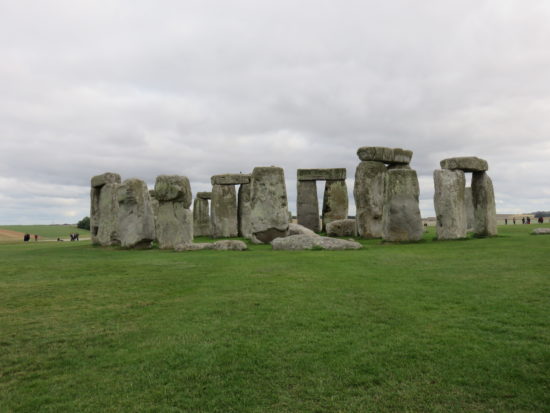
As National Trust members, I pre-booked our free tickets online the day before visiting. When pre-booking online you are prompted to select a 30 minute time bracket in which you intend to arrive. We decided to visit late in the day hoping that it would be quieter. Since I had pre-booked for a set time, I was expecting to get in relatively quickly. However, when we arrived, the line for the pre-booked tickets and the line to buy tickets were of similar length. Now you would think that the line for pre-booked tickets would move much faster than those lining up to buy tickets. However, after waiting in line for 40 minutes it soon become apparent that the line for pre-booked tickets was taking much longer. In addition, I soon discovered that the pre-selection of entry times is just a way for them to manage visitors, and doesn’t mean you get any kind of priority entry for your booked time. The longer we waited, the more frustrated I got. When we finally made it to the front of the line, we were told that they had run out of English guides, so by this point I was rather disappointed with the management of this site.
Anyhow, keen to get on with our visit following our long wait to get in, we started walking up the path to Stonehenge. There are regular shuttle buses than run back and forth as the stone circle is 1.5 miles from the visitor centre. We chose to walk, as Stonehenge is in a lovely countryside setting. The bus stops halfway so you can walk part of the way if you wish to.
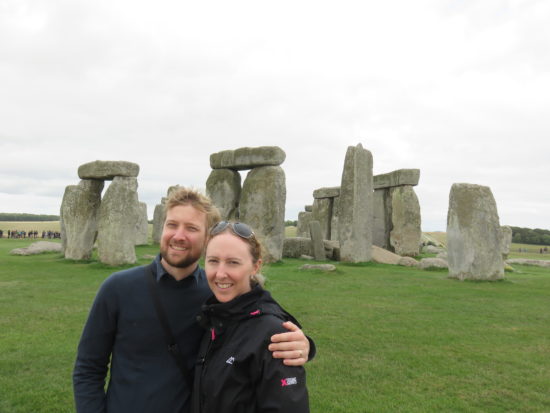
Once we finally reached the stone circle we needed to show our tickets again since anyone can go for a walk in the surrounding countryside since it is owned by the National Trust and open to the public. It was fairly quiet when we arrived at the stone circle, as it was quite late in the afternoon, so we felt like we could take our time and enjoy our visit without feeling jostled by the crowds. I must admit, I hadn’t come with any great expectations, because after seeing Stonehenge so much over the years on TV and on the internet, I was worried I had been overexposed and that it would take away some of the awe. However, despite this I found it hard not to be impressed by these massive stones. Especially when I reflected on the immense effort that had gone into moving and positioning these stones at a time when living was hard.
You can’t get up close or touch the stones, as there is a ringed off path that runs around the perimeter of the stone circle. However, if you want the opportunity to get access to the inner circle, then there is a special guided tour that takes you to Stonehenge after hours when the tourists have left. We took our time walking around the circle because as your position changes, your view of the circle and stone arrangement does as well. Behind Stonehenge runs the rather busy A303 which somewhat ruins the ambience of the place. I can only imagine how many accidents this must cause, as most cars we saw driving past slowed down to look.
The exhibition at the Visitor Centre and information boards at the site provided some further information on how and when Stonehenge was created. Basically, Stonehenge consists of a ring of standing stones, with each around 13 feet (4.0 m) high, seven feet (2.1 m) wide and weighing around 25 tons. The stones are set within earthworks in the middle of the most dense complex of Neolithic and Bronze Age monuments in England, including several hundred burial mounds called ‘barrows’. You can see these barrows dotted around the countryside surrounding Stonehenge. Almost all of the barrows have been opened by investigators and treasure hunters prior to the 20th century and have had their grave goods removed. If you are interested in reading more, here is a blog post by Stonehenge Circle News and Information on the Stonehenge Burrows.
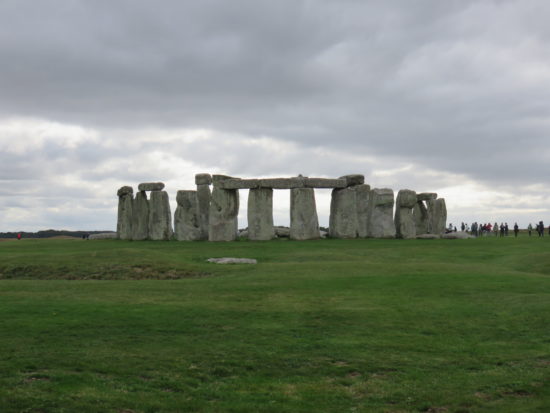
Archaeologists believe Stonehenge was constructed over a long period of time from 3000 BC to 2000 BC. The surrounding circular earth bank and ditch is the earliest phase of the monument and has been dated to about 3100 BC. Radiocarbon dating suggests that the first bluestones were raised between 2400 and 2200 BC, although they may have been at the site as early as 3000 BC.
There are a lot of theories about why Stonehenge was created, but nobody knows for sure, and this is one of the reasons this site is so captivating. Two things fascinate me most about Stonehenge. Firstly, is that the trilithon (the encompassing horseshoe arrangement of the five central trilithons, the heel stone, and the embanked avenue) aligns to the sunset of the winter solstice and the opposing sunrise of the summer solstice. This took high level precision and intelligence to achieve without the technology we rely on today.

The second is the huge stones and their origins. The large sarsen stones that make the trilithon (the two uprights and a lintel), come from the Marlborough Downs which is about 25 miles (40 km) away. The smaller bluestones in the circle come all the way from Wales which is around 150 miles (240 km) away. The people who brought them to this site did so at great effort, so they must have felt a compelling reason to do so.
After visiting the stone circle, we took another path that ran through the fields back to the visitor centre. Alongside the famous stone circle, there are several other sites to see at the visitor centre, including replica Neolithic houses, an exhibition, cafe and gift centre. When we arrived back at the centre, we took a closer look at the replica Neolithic houses. These houses are open to visitors to touch, explore, and imagine how life might have been all those years ago. I’ve added an English Heritage video below that talks through the construction of these houses.
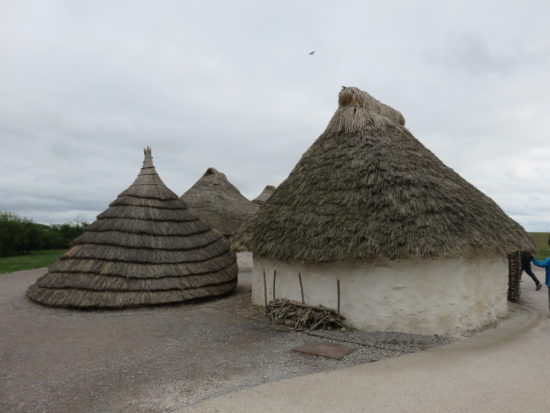
Before leaving, we visited the onsite exhibition which I felt was a bit of a let down. However, when we first entered, I enjoyed the ‘Standing in the Stones’ audio-visual display which gives you a 360 degree view from inside the stones and takes you through the four seasons and its changing landscape. However, the rest of the exhibition I found a bit boring. There was information about the history of Stonehenge and some interesting items on display, but overall, it is quite small and not a lot to see. Apparently, these items are on loan from museum partners, including the Salisbury Museum and Wiltshire Museum, so maybe these museums have a larger collection worth seeing.
So was Stonehenge worth visiting? I was lucky enough to get a free ticket with my National Trust membership, so that may have skewed my view somewhat. Nonetheless, I was impressed by this magnificent stone site and enjoyed my visit and would recommend it to people who enjoy and appreciate historical sites.
How to Visit Stonehenge on a Budget
The ticket price for Stonehenge is rather eye watering. Unfortunately, it is an expensive place to visit, but there are a few ways you can do it more cheaply. If you are an English Heritage or National Trust member, you can get a free ticket. If you are visiting these types of sites regularly, then a membership is good value and a very economical choice. I know we get a lot of use out of our National Trust membership. Purchasing your ticket in advance online will also save you a few pounds compared to the walk-up price.
Don’t pay the extra money for an audio guide, instead, just download the FREE English Heritage Trust, Stonehenge App on iTunes or Google Play.
If you don’t mind seeing Stonehenge from afar, then just pay for the on-site parking and walk over to Stonehenge on the National Trust path in the surrounding countryside. You can get relatively close to Stonehenge without a ticket, and as it is a large site, you can easily admire it from a distance.
If you are flexible with your time, then plan your visit around the solstices, as access is free on these occasions. You can visit the site at sunrise and sunset for free. However, following the sunrise/sunset, you need to leave to make way for the arrival of paying visitors or for the nightly closure. As you can imagine, these are popular times to visit, so if driving, arrive very early to get a car park or take other transport options.
The other option is seeing it from the road along the A303, which skirts the site. However, I really would not recommend this as it is a fast road, and it is very dangerous to slow down to look. You could end up causing a serious accident.
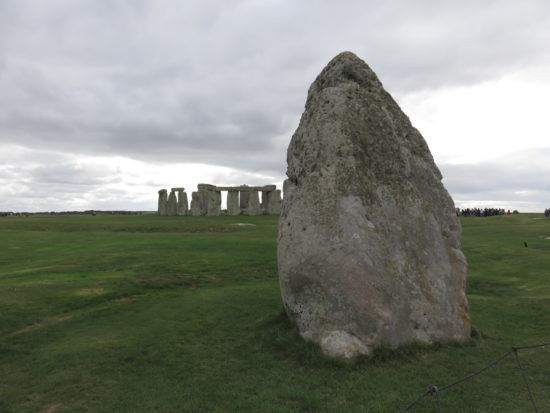
Practical Tips for Visiting Stonehenge
- How to get to Stonehenge
- By Car: We drove to Stonehenge. Access to the car park is off the A360 at Airman’s Corner.
- Public Transport: Travel to the Salisbury train or bus station and from there you can get The Stonehenge Tour Bus public bus which departs from both stations.
- Tours: You can visit Stonehenge on a tour. Tours usually include other interesting sites in the area:
- Inner Circle Access of Stonehenge, including Bath and Lacock Day Tour from London – If you want the chance to get inside Stonehenge’s inner circle, then take this exclusive access tour.
- Full-Day Tour of Salisbury and Stonehenge from Salisbury – If you want to combine a visit to Stonehenge and nearby Old Sarum (see more below).
- Stonehenge, Windsor Castle, and Bath from London
- Stonehenge and Bath Day Trip from London
- Booking tickets: Stonehenge gets busy, so I would recommend pre-booking tickets online. It will also save you a few pounds.
- National Trust members get free tickets to Stonehenge: In order to get your free ticket, you must pre-book in advance online.
- Audio Guide: Download the FREE English Heritage Trust, Stonehenge App on iTunes or Google Play.
- How long should I visit Stonehenge for? It depends if you want to walk or take the bus to the stone circle and whether you want time to explore the exhibition and Neolithic village. If you are walking and enjoying the countryside and other attractions, then allocate about 3 hours. If taking the bus to the stone circle, then 1.5-2 hours.
- When should I visit Stonehenge? To avoid the crowds, aim to arrive early morning or late afternoon. The last entry is 2 hours before closing, so check the closing times on the English Heritage website to ensure you don’t arrive too late in the afternoon.
- Weather: If you are visiting Stonehenge on a rainy day, then wear waterproofs as there is no shelter out at the stone circle.
- Toilets: Toilets are located at the Visitor Centre.
- Language: Information guides are available in a range of languages.
- Currency: British pound. There is no cash machine/ATM in the village. However, shops typically take card.
- Tipping: Not required, but people usually round up.
- Electricity: The electrical current is 230 volts AC. Wall outlets take a three pronged plug only used in the United Kingdom and Ireland. However, you are better off purchasing a worldwide adaptor that can be used in the United Kingdom as well other countries. At least then you can potentially get some further use out of it on future vacations. If you’re taking several electronics with you, then I would recommend purchasing a couple of these adaptors.
- Driving: In the UK they drive on the left hand side of the road with speed signs in miles per hour (mph).
- Navigating: We used Google’s free Offline Maps. Google Offline Maps allows you to access free maps for navigating that can be used offline i.e. you don’t need WIFI, data, or roaming to be able to use them. Follow my detailed guide on how to use Google’s Offline Maps.
- Using your phone as a GPS will drain your battery quickly, so use a portable battery charger which you can use to charge your phone and any other USB chargeable devices.
- If you prefer a paper map, then purchase a road map before you go. At least it’s reliable and won’t run out of battery or malfunction like the electronic options!
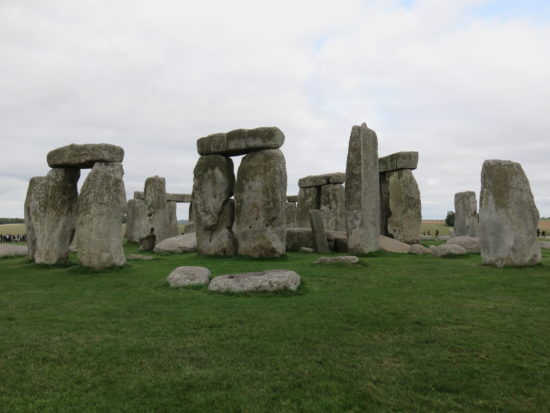
Old Sarum
A short drive from Stonehenge is another English Heritage site called Old Sarum, which is worth visiting if you are in the area and have the flexibility of self-driving. However, you can also get to Old Sarum by bus from Salisbury. We visited Old Sarum before heading over to Stonehenge in the afternoon. You don’t need to book tickets in advance, just pay when you arrive. Onsite parking is £2 which is refundable when you buy an entry ticket, which doesn’t cost very much and is free for English Heritage members. It was very busy when we arrived, so they were redirecting everyone into the overflow parking in the nearby field, which was about a 10 minute walk from the site.
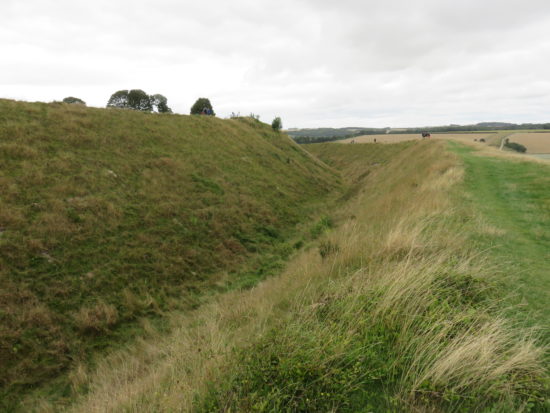
Old Sarum is the site of the earliest settlement of Salisbury. This site dates back to 3000 BC, but the remains you see at this site today is from an Iron Age hillfort which was erected around 400 BC. In the following years, the site continued to be occupied during the Roman period, and then by the Saxons in the 6th century. Later, it was used as a stronghold against marauding Vikings. Then the Normans constructed a motte and bailey castle (a fortification with a stone or wood keep on raised earth), a stone curtain wall, and a great cathedral. A royal palace was built within the castle for King Henry I and was subsequently used by Plantagenet monarchs, a royal house which originated from the lands of Anjou in France.
But eventually disputes between the Sheriff of Wiltshire and the Bishop of Salisbury led to the removal and relocation of the church in the early 13th century to what is now Salisbury. The buildings on Old Sarum were dismantled for their stone, and eventually the old town and its neglected castle were abandoned by Edward II in 1322 and sold by Henry VIII in 1514.
After arriving, we headed up to the main entry point and decided to take a walk around the site before heading in. There is a path that runs around the site and is about 1 mile long. If you have time, there are lots of wonderful walks to enjoy in the surrounding countryside. Once we reached the entrance point again, we headed in to explore the site. The outer circle ward was where the old village stood, and you can see the exposed foundations of the old cathedral. I really enjoyed crossing Old Sarum’s wooden bridge and stepping into the heart of what was once a bustling medieval castle.


Practical Tips for Visiting Old Sarum
- How to Get to Old Sarum:
- By Car: Old Sarum is about 2 miles north of Salisbury, off the A345. It is only 17 minutes drive from Stonehenge along the A360.
- Public Transport: There is a train station in nearby Salisbury, which is 2 miles away. There are buses that run from Salisbury to Old Sarum.
- Tours: You can also visit Old Sarum on a tour:
- Full-Day Tour of Salisbury and Stonehenge from Salisbury – A combined visit to Stonehenge and Old Sarum
- Toilets: The toilets are situated next to the main car park, within Second World War bunkers set into the bank.
- How long should I visit Old Sarum for? If you want to walk around both the perimeter and the site, then put aside at least a couple of hours.
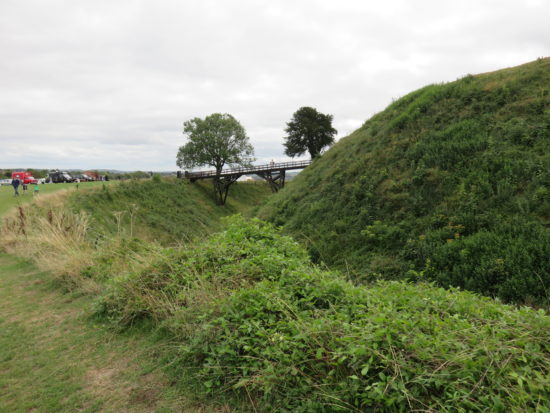

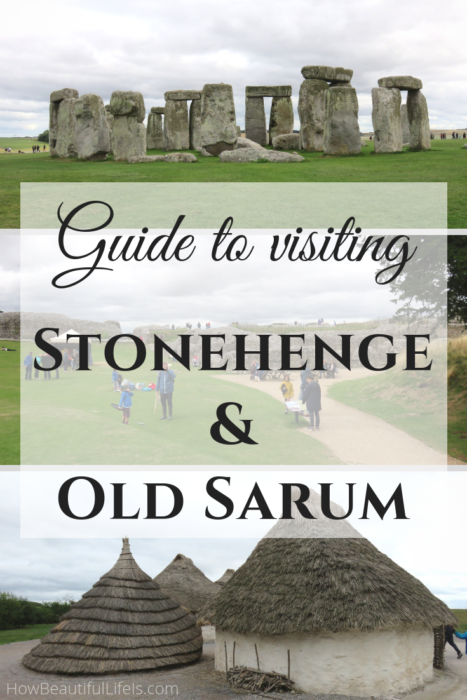



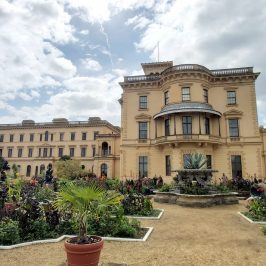



Leave a Reply